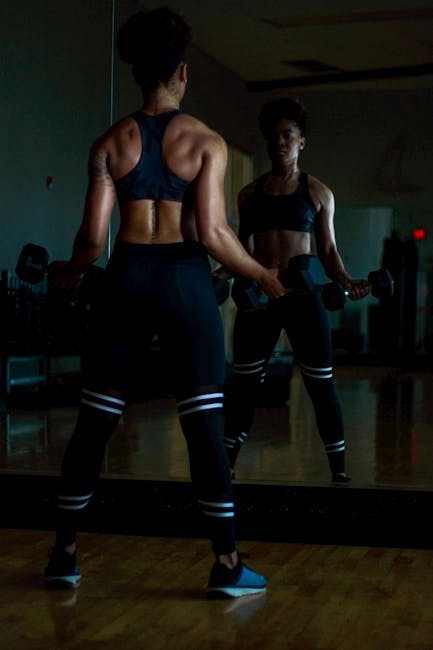Ah, the joys of weightlifting. The rush of endorphins, the feeling of invincibility, the… inner elbow pain? Yes, unfortunately, sometimes our beloved hobby can come with a pesky side effect. But fear not, my fellow weightlifters, managing inner elbow pain during weightlifting is possible. And no, the solution is not to simply stop lifting weights. So let’s dive in and explore some ways to keep that pesky pain at bay. Because who needs an elbow anyway, right? Just kidding, we all do. Let’s get started.
Contents
- 1 1. Introduction: Understanding Inner Elbow Pain During Weightlifting
- 2 2. Causes of Inner Elbow Pain: Overuse, Incorrect Technique, and More
- 3 3. Identifying and Diagnosing Inner Elbow Pain: When to Seek Medical Attention
- 4 4. Managing Inner Elbow Pain: Rest, Ice, Strengthening Exercises, and More
- 5 5. Preventing Inner Elbow Pain: Proper Warm-Up, Stretching, and Technique Tips
- 6 Goodbye, Pain! Hello, Gain!
1. Introduction: Understanding Inner Elbow Pain During Weightlifting
Don’t you just hate it when your elbow feels like it’s being twisted off during weightlifting? Inner Elbow Pain is a common issue amongst avid weightlifting enthusiasts like yourself. It can happen when you strain your elbow joint by gripping or lifting incorrectly. The solution, however, is not to avoid weightlifting altogether.
Believe it or not, there are actually ways to prevent inner elbow pain during weightlifting. One of them is by ensuring you have the right technique. For example, avoid hyperextending your elbow while lifting weights, always ensure that the weight is evenly balanced on both sides, and avoid using a tight grip during lifting. Another method is by doing exercises that increase strength and flexibility in your arms.
Lastly, to combat inner elbow pain, it’s important to listen to your body. If you feel pain, take a break and rest your elbow before resuming your exercises. A little downtime can go a long way in preventing long-term damage and getting you back to lifting in no time. Now, let’s delve into some of the exercises and techniques you can incorporate into your routine to help prevent inner elbow pain.

2. Causes of Inner Elbow Pain: Overuse, Incorrect Technique, and More
If you’ve ever experienced inner elbow pain, you know how frustrating it can be. Whether you’re an athlete or just someone who likes to stay active, throwing, lifting, and swinging can become unbearable when you’re dealing with this kind of discomfort. In order to understand how to prevent inner elbow pain, it’s important to know what causes it. Spoiler alert: it’s usually because you’re doing something wrong.
First off, let’s talk about overuse. If you’re constantly using your arm, whether it’s swinging a tennis racket or typing away on a keyboard, you’re at risk for developing inner elbow pain. Remember, your muscles need time to rest and recover after a tough workout. If you don’t take breaks, your inner elbow will pay the price.
Next up: incorrect technique. This one’s tricky because you may not even realize you’re doing something wrong. Maybe you’ve been playing golf for years and have never had an issue, but suddenly you’re feeling that pesky inner elbow pain. It’s possible that your technique needs some tweaking. Ask a coach or a friend with experience to watch you play and offer some tips. Sometimes all it takes is a small adjustment to your form to get rid of the pain.
- But wait, there’s more! Other causes of inner elbow pain can include
- Poor posture
- Tight muscles
- Age
Bottom line? Inner elbow pain can be a real pain in the, well, elbow. But by taking breaks, reviewing your technique, and paying attention to other factors that could contribute to the pain, you can hopefully avoid it altogether. And if you do end up with inner elbow pain, don’t fret – just think of it as an excuse to finally take a break from all those push-ups. Cheers to healing and pain-free arms!
3. Identifying and Diagnosing Inner Elbow Pain: When to Seek Medical Attention
So, you’ve got some pain in your inner elbow and you’re wondering what to do about it. Should you just ignore it like you do your ex’s texts, or is it time to seek medical attention? Let’s take a look at some possible scenarios.
First and foremost, if your inner elbow pain is accompanied by any of the following, it’s time to call the doc: swelling, redness, fever, or if you suddenly find yourself able to speak in tongues. Okay, that last one might be a bit of a stretch, but you get the idea. If it looks like you’ve got something more serious going on, then it’s time to seek medical attention.
If your inner elbow pain only happens when you’re doing certain activities, then you might want to try some home remedies before hopping on WebMD. You could try icing, taking an over-the-counter painkiller, or getting your cat to lick the spot. (Okay, that last one is definitely not a real remedy, but bonus points if you try it and let me know what happens!)
Finally, if your inner elbow pain has been going on for more than a few days and isn’t getting better, it’s definitely time to talk to someone who knows what they’re talking about. You don’t want to end up like that guy who thought his broken ankle was just a sprain and then ended up limping for months. Don’t be that guy, y’all.
4. Managing Inner Elbow Pain: Rest, Ice, Strengthening Exercises, and More
Managing inner elbow pain can be a real pain in the… well, you know what. But fear not, fellow sufferers, because there are plenty of ways to ease the ache and get your joint back in action. Here are some tips to help you tackle that pesky elbow pain.
Rest, rest, rest. Sure, we all want to be weekend warriors and brag about our latest CrossFit workout. But sometimes, our bodies need a break. So take a chill pill (not literally, unless prescribed by a doctor) and give your elbow some time to recuperate. It’s also a great excuse to binge-watch your favorite shows and catch up on some much-needed R&R.
Ice, ice baby. No, not Vanilla Ice. Ice packs. They can do wonders for your inner elbow pain. Wrap it up in a towel and apply it to the affected area 20 minutes at a time. It helps reduce inflammation and numb the pain. And if you’re feeling really fancy, try a frozen bag of peas. It works just as well, but adds a touch of quirkiness to your injury.
Strengthening exercises. Move over, Rocky. You’re not the only one who can do one-handed push-ups. Strengthening exercises can help alleviate inner elbow pain and prevent future injuries. Try some wrist curls, tricep dips, and bicep curls. Just make sure to use light weights and start slow. You don’t want to be in more pain than before. And remember, Rome wasn’t built in a day. So take your time and be patient. Your elbow will thank you.
5. Preventing Inner Elbow Pain: Proper Warm-Up, Stretching, and Technique Tips
Inner elbow pain can be a real buzzkill. You’re ready to hit the court or the field, but your elbow won’t let you. Fear not! With these proper warm-up, stretching, and technique tips, you can say “Hasta la vista, baby” to inner elbow pain. And who knows, you might even become the next MVP. Ok, probably not, but at least you’ll be pain-free.
Warm-Up Tips
- Start slowly for about 5-10 minutes to get your joints ready for action.
- Do some light exercises like jumping jacks or running in place.
- Add some specific movements to target your arms and upper body, like arm circles or elbow curls.
- Don’t forget to warm up your inner elbow with some light stretching and rotation exercises.
Stretching Tips
- Stretch before and after exercising to keep your body limber and prevent injury.
- Do some wrist extensions to stretch out the muscles in your forearm and elbow.
- Give the tricep stretch a go. Extend one arm overhead and bend it. Take your other arm behind your head and gently press your elbow towards your head.
- Finish off with a bicep stretch. Bend your arm behind your head and hold it in place with your other hand.
Technique Tips
- Use proper form when doing exercises or playing a sport. This will help to reduce the risk of injury.
- If you’re feeling any pain, immediately stop and rest.
- Mix up your activities to avoid overuse injuries.
- Try to avoid bending your elbows too much, as this can cause repetitive stress on the inner elbow.
Goodbye, Pain! Hello, Gain!
Now that you know the secret to managing inner elbow pain during weightlifting, you’ll be able to pump some serious iron without dealing with the agony of tennis elbow. Say goodbye to curse words flying out of your mouth every time you lift that barbell and hello to impressive gains.
Remember, it’s important to listen to your body and ease into weights gradually. Keep in mind that patience and persistence are key when it comes to achieving your fitness goals. So, what are you waiting for? Grab your dumbbells, adjust your form, and get ready to crush your inner elbow pain! Your gains are waiting for you!








Leave A Comment